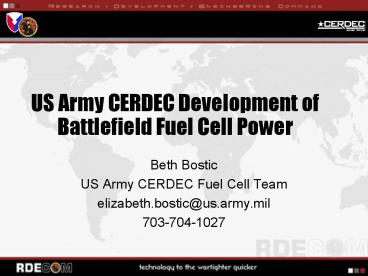US Army CERDEC Development of Battlefield Fuel Cell Power - PowerPoint PPT Presentation
Title:
US Army CERDEC Development of Battlefield Fuel Cell Power
Description:
FACT: Over Half of today's 'Highly digitized C4ISR' Force is powered by 1980's Generators. ... kerosene-based fuels such as JP-8 and JP-5 for land and ground forces ... – PowerPoint PPT presentation
Number of Views:113
Avg rating:3.0/5.0
Title: US Army CERDEC Development of Battlefield Fuel Cell Power
1
US Army CERDEC Development of Battlefield Fuel
Cell Power
- Beth Bostic
- US Army CERDEC Fuel Cell Team
- elizabeth.bostic_at_us.army.mil
- 703-704-1027
2
Agenda
- Current Power Problem
- What is a Fuel Cell?
- Army Areas of Focus
- Benefits and Technical Challenges
- The Fuel Issue
- The Path Forward
3
The Power Problem
- FACT Over Half of todays Highly digitized
C4ISR Force is powered by 1980s Generators.
They are outdated and unreliable.
4
Battlefield Power
SOLDIER
MOBILE
POWER GAP
Tactical Operation Center
- Brigade
- Disposable batteries are costly
- Available energy NOT fully utilized
- No Recharge capability
- Too many battery types
No non-battery power away from vehicles, gensets,
or wall plugs
- SBCT I
- 1,200 gals fuel/day to theater costs vary (13
- 133/gal) - 133 Generators ( MTOE )
- Too Large, Too Noisy, Not Efficient
- Redundant Generators
- No Smart Power Distribution
- 700K for 72 hrs
- 7 TONS of batteries!
- 68 TONS of generators!
- 45K-465K (72 hrs)
- 12 TONS Fuel!
5
Potential Power Solutions
- Advanced Disposable Batteries
- Lithium Ion Pouch/Polymer Batteries
- Fuel Cells
- Stirling Engines
- Flexible Solar Panels
- Metal-Air Batteries
- Advanced Internal-Combustion Generators
Soldier Sensor Power Battery Recharging Auxiliar
y Power Units Fuel Reforming Component
RD Vehicle Applications
6
What is a Fuel Cell?
Electrochemical Energy Conversion Device PEM Fuel
Cells take in Hydrogen and Air (Oxygen) and,
through a chemical reaction, make Water and
Electricity.
7
CERDEC Focus Areas
Located at Fort Belvoir, VA approximately 20
miles south of Washington, DC
Soldier and Sensor Power (0-100W)
Battery Charging (100-500W)
Auxiliary Power Units (500W-10kW)
Goal Transition Technology to areas where it is
needed most.
8
Army Fuel Cell Structure
9
DoD Fuel Cell Efforts
10
Benefits of Fuel Cell Technology
- Decreased acoustic signature
- Decreased thermal signature
- Longer, Lighter missions
- Improved Efficiency
- Increased Power Density
- Significant Fuel Savings
- Hybrid systems offer the best solution
11
Technical Challenges
- Rugged System, durability in harsh environments
- Reduce System Size and Weight
- Reliability
- Balance of Plant Components
- Air side contamination
- Water Management
- Reduce Acoustic and Thermal Signatures
- Orientation independent operation
- Power Quality
- Unit Cost
12
The Fuel Policy
- 1999 DoD One Fuel Forward Policy states that
the military can only develop or acquire power
technologies that utilize currently supported
military logistic fuels. - kerosene-based fuels such as JP-8 and JP-5 for
land and ground forces
Larger power fuel cell power systems (gt500W) must
be logistically fueled.
PROBLEM Logistic Fuels are not easily reformed
into a hydrogen rich stream compatible with fuel
cells.
13
Fuel Reforming Issues
- What is the target fuel cell?
- Sulfur Removal
- Regenerable Approach is preferred
- Sulfur levels are variable in logistics fuel up
to 3000ppm - Carbon Formation
- Function of operating parameters
- Sensitive trade off of performance
- Water Management
- Prefer NO external water source needed
- System Performance
- Efficiency
- Start-up Time
- Transient response
- Thermal cycling
14
Silent Tactical Power Efforts
Logistics Fuel Reforming is critical
- FY 08 Target ? 2-5kW Quiet Power Source
- lt 150 kgs, lt 69dBA noise
- TRL 5
- JP-8 Fueled
- System Specs
- Two 1kW Methanol Reforming PEM units
- 1kW Prototype Liquid Hydrocarbon fuel reforming
system - 85-100 kg
- 29 x 27 x 25
15
Tactical Power Benefits
- 2kW Fuel Cell for C3OTM
- 2003 Demonstration
- Provided Silent Watch Capability
- Thermally undetectable from three sides.
16
The Path Forward
- Reduce logistic footprint for power!
- Focus on Near-Term Military Applications
- Soldier Sensor Power
- Auxiliary Power Units
- Portable Battery Chargers
- Fuel cells have the potential to significantly
reduce weight costs over traditional military
power sources - Main Technology Barriers to Military Adaptation
- Fuel Supply
- Affordability, and Reliability/Durability in the
Field - Large Systems (500W) must use Logistics Fuels
17
Questions?
- Beth Bostic
- US Army CERDEC Fuel Cell Team
- elizabeth.bostic_at_us.army.mil
- 703-704-1027































